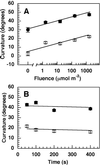The enhancement of phototropin-induced phototropic curvature in Arabidopsis occurs via a photoreversible phytochrome A-dependent modulation of auxin responsiveness
- PMID: 11402210
- PMCID: PMC111172
- DOI: 10.1104/pp.126.2.826
The enhancement of phototropin-induced phototropic curvature in Arabidopsis occurs via a photoreversible phytochrome A-dependent modulation of auxin responsiveness
Abstract
The induction of phototropism in etiolated (dark-grown) seedlings exposed to an unidirectional pulse or extended irradiation with low fluence rate blue light (BL) requires the action of the phototropin (nph1) BL receptor. Although cryptochromes and phytochromes are not required for phototropic induction, these photoreceptors do modulate the magnitude of curvature resulting from phototropin activation. Modulatory increases in the magnitude of phototropic curvature have been termed "enhancement." Here, we show that phototropic enhancement is primarily a phytochrome A (phyA)-dependent red/far-red-reversible low fluence response. This phyA-dependent response is genetically separable from the basal phototropin-dependent response, as demonstrated by its retention under extended irradiation conditions in the nph4 mutant background, which normally lacks the basal BL-induced response. It is interesting that the nph4 mutants fail to exhibit the basal phototropin-dependent and phyA-dependent enhancement responses under limiting light conditions. Given that NPH4 encodes a transcriptional activator, auxin response factor 7 (ARF7), we hypothesize that the ultimate target(s) of phyA action during the phototropic enhancement response is a rate-limiting ARF-containing transcriptional complex in which the constituent ARFs can vary in identity or activity depending upon the irradiation condition.
Figures




Similar articles
-
Hypocotyl growth orientation in blue light is determined by phytochrome A inhibition of gravitropism and phototropin promotion of phototropism.Plant J. 2004 Dec;40(5):826-34. doi: 10.1111/j.1365-313X.2004.02256.x. Plant J. 2004. PMID: 15546364
-
Phytochromes A and B mediate red-light-induced positive phototropism in roots.Plant Physiol. 2003 Mar;131(3):1411-7. doi: 10.1104/pp.013847. Plant Physiol. 2003. PMID: 12644690 Free PMC article.
-
Phytochrome regulation of pea phototropin.J Plant Physiol. 2004 Mar;161(3):265-70. doi: 10.1078/0176-1617-01228. J Plant Physiol. 2004. PMID: 15077624
-
Phytochromes, cryptochromes, phototropin: photoreceptor interactions in plants.Photochem Photobiol. 2000 Jan;71(1):1-11. doi: 10.1562/0031-8655(2000)071<0001:pcppii>2.0.co;2. Photochem Photobiol. 2000. PMID: 10649883 Review.
-
The phototropin family as photoreceptors for blue light-induced chloroplast relocation.J Plant Res. 2003 Feb;116(1):77-82. doi: 10.1007/s10265-002-0072-4. Epub 2002 Dec 21. J Plant Res. 2003. PMID: 12605303 Review.
Cited by
-
Molecular genetic analysis of phototropism in Arabidopsis.Plant Cell Physiol. 2012 Sep;53(9):1517-34. doi: 10.1093/pcp/pcs111. Epub 2012 Aug 3. Plant Cell Physiol. 2012. PMID: 22864452 Free PMC article. Review.
-
Phytochrome-hormonal signalling networks.New Phytol. 2003 Mar;157(3):449-463. doi: 10.1046/j.1469-8137.2003.00689.x. New Phytol. 2003. PMID: 33873406 Review.
-
Arabidopsis fhl/fhy1 double mutant reveals a distinct cytoplasmic action of phytochrome A.Proc Natl Acad Sci U S A. 2007 Jun 19;104(25):10737-42. doi: 10.1073/pnas.0703855104. Epub 2007 Jun 12. Proc Natl Acad Sci U S A. 2007. PMID: 17566111 Free PMC article.
-
PHYTOCHROME KINASE SUBSTRATE 1 is a phototropin 1 binding protein required for phototropism.Proc Natl Acad Sci U S A. 2006 Jun 27;103(26):10134-9. doi: 10.1073/pnas.0603799103. Epub 2006 Jun 15. Proc Natl Acad Sci U S A. 2006. PMID: 16777956 Free PMC article.
-
A single chromoprotein with triple chromophores acts as both a phytochrome and a phototropin.Proc Natl Acad Sci U S A. 2006 Nov 21;103(47):17997-8001. doi: 10.1073/pnas.0603569103. Epub 2006 Nov 8. Proc Natl Acad Sci U S A. 2006. PMID: 17093054 Free PMC article.
References
-
- Behringer FJ, Davies PJ. Indole-3-acetic acid levels after phytochrome-mediated changes in the stem elongation rate of dark- and light-grown Pisum seedlings. Planta. 1992;188:85–92. - PubMed
-
- Casal JJ. Phytochromes, cryptochromes, phototropin: photoreceptor interactions in plants. Photochem Photobiol. 2000;71:1–11. - PubMed
Publication types
MeSH terms
Substances
LinkOut - more resources
Full Text Sources
Molecular Biology Databases

